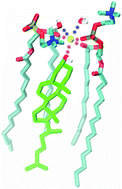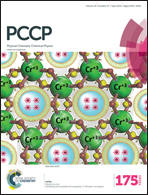Free energy landscapes of sodium ions bound to DMPC–cholesterol membrane surfaces at infinite dilution†
Abstract
Exploring the free energy landscapes of metal cations on phospholipid membrane surfaces is important for the understanding of chemical and biological processes in cellular environments. Using metadynamics simulations we have performed systematic free energy calculations of sodium cations bound to DMPC phospholipid membranes with cholesterol concentration varying between 0% (cholesterol-free) and 50% (cholesterol-rich) at infinite dilution. The resulting free energy landscapes reveal the competition between binding of sodium to water and to lipid head groups. Moreover, the binding competitiveness of lipid head groups is diminished by cholesterol contents. As cholesterol concentration increases, the ionic affinity to membranes decreases. When cholesterol concentration is greater than 30%, the ionic binding is significantly reduced, which coincides with the phase transition point of DMPC–cholesterol membranes from a liquid-disordered phase to a liquid-ordered phase. We have also evaluated the contributions of different lipid head groups to the binding free energy separately. The DMPC's carbonyl group is the most favorable binding site for sodium, followed by DMPC's phosphate group and then the hydroxyl group of cholesterol.


 Please wait while we load your content...
Please wait while we load your content...